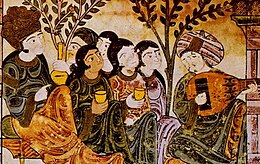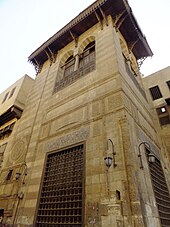Sabil (fountain)

| Part ofa serieson |
| Arabic culture |
|---|
 |
Asabilorsebil(Arabic:سبيل,romanized:sabīl;Turkish:sebil) is a small kiosk in theIslamic architecturaltradition where water is freely dispensed to members of the public by an attendant behind a grilled window. The term is sometimes also used to refer to simple unmanned fountains with a tap for drinking water,[1]though other names often exist for such fountains (such asçesmein Turkish).[2]
Historically, sabils are structures of both civic and religious importance inMuslimcities, most prominently in the cities of theOttoman Empire,[3][4]based inIstanbul,and of theMamluk Empire,based inCairo.[5]They were built atcrossroads,in the middle of city squares, and on the outside of mosques and other religious complexes to providedrinking waterfor travelers and to assistritual ablutionsbefore prayer.
Etymology
[edit]The wordsabilcomes from theArabic verb rootsabala(سبل) meaning "to let fall, drop, to let hang down, to close eyes or to shed tear".[6]: 34 Sabilinitially meant "road" or "path" and is used both metaphorically and literally in multiple instances in the Qur'an.[6]Its use as an architectural term for a public water building or fountain likely derives from a more abstract meaning it acquired to refer to general acts or provisions done for the sake of God (such as a charitable act).[6][7]
Description and function
[edit]A typical sabil was built over an undergroundcisternwhich supplied the water for distribution.[8]In some cases, the water drawn from the cistern then ran down a decorative carved marble panel called asalsabil,which may also have served the purpose of aerating the water as it came from the cistern.[8]: 63, 262 An attendant collected the water and distributed it to passers-by outside the sabil, usually through a window with a metalgrille.
This service was free to members of the public, and was paid for by the revenues or funds of a charitable endowment, an Islamicwaqf,provided or set up by the patron who commissioned the building.[8][3][5]Endowing money for the construction of sabils was considered an act of piety, and the construction of many sabils was considered the hallmark of a beneficent ruler.[7][9]
-
The street facade of the Sabil of Tusun Pasha (or Sabil of Muhammad Ali), Cairo, completed in 1820.
-
Water dispensing area inside the sabil. (Sabil of Tusun Pasha or Muhammad Ali, Cairo, 19th century.)
-
The underground water cistern for the sabil. (Sabil of Tusun Pasha or Muhammad Ali, Cairo, 19th century.)
History
[edit]Origins in the Islamic world
[edit]
During the formative period ofearly Islamic society(seventh century onward), the Islamic world inherited the water traditions of thelate antiquityMediterraneanworld (formerly underRomanandByzantinerule) andIranian world(formerly underSasanianrule).[10]Islamic society developed existing methods into new ones or revived neglected ones.[10]In addition to the regular water needs for drinking and for agriculture, water also had an important religions role in theablutionsor purification ritual required before prayer inIslam,such that even early mosques were equipped with either a water basin or fountain.[10][6]Water also had other religious or spiritual symbolic importance, being associated withParadise(heaven) and being used in theQur'anas a symbol of Creation.[6]The Qur'an describes water as a blessing from God (Allah), and somehadithsexhort Muslims to offer water to thirsty humans and animals.[6]
As a result, water became an important element in Islamic architecture, both as a practical/religious provision as well as for aesthetic effects.Hammams(public bathhouses), inherited from the Romanthermae,continued to be an essential public facility in Islamic cities in addition to public fountains. At the same time, water was featured in palace and garden design as early as theUmayyad Caliphate(7th–8th centuries).[9]It played a role in formal gardens (such asPersian gardens) and in palace architecture such as in the famous example of theAlhambrain Spain.[10]
How the architectural format of the sabil itself first developed is debated. While water was implicated in architectural design across theMuslim world,the sabil as a recognizable structure with a particular purpose is associated mainly with theMamluk Sultanateand with theOttoman Empire,with bothIstanbulandCairohaving numerous examples.[6]Its architecture has been argued to draw inspiration from the descriptions of Paradise in the Qur'an.[6]
Sabils in Mamluk Cairo
[edit]
The oldest sabil for which we have a date is inDamascus,Syria,and is dated to 1077–78CE(570AH) according to its inscription, which is well beforeAyyubidor Mamluk rule inEgyptand Syria. The earliest (surviving) sabil in Cairo is the one installed by the Mamluk sultanal-Nasir Muhammadat the corner ofhis father's monumentalhospital-madrasa-mausoleum complexduring restorations in 1325–26.[6][8][5]AsMamluk architecturedeveloped, sabils became a standard feature of the religious and funerary complexes built by the Mamluk elites and also came to be typically accompanied by akuttab(a space offering primary education, especially reading of the Qur'an).[6][5][8]These "sabil-kuttab" structures were often located at the corner of the building complex along a busy road or at an intersection.[6]The sabil was located at ground or street level (where it was accessible to passersby) while the kuttab was usually above it on the upper levels. Mamluk sabils had facades with large windows covered by heavy bronze grilles and their exteriors were well-decorated, typically with stone-carving along their surfaces and with multi-coloured marble panels above the windows.[6]The interiors were also typically decorated with marble mosaics and with painted wooden ceilings, while the water from the cistern often trickled over an ornamental carved marble panel (known as asalsabil) before being collected by the sabil's attendant.[6][8]
During the Mamluk period, such structures were almost always integrated into a larger building, and were rarely ever built as separate or stand-alone structures.[6]The earliest free-standing or independent sabil-kuttab was the one built by SultanQaytbayin 1479 (theSabil-Kuttab of Qaytbay) alongSaliba Street.[11][8]It was only underOttoman rule(from 1517 onward) that independent sabil-kuttabs became a common building type in Cairo, with notable examples like theSabil-kuttab of Abd al-Rahman KatkhudaatBayn al-Qasrayn.[8]This was in part because the Ottoman governors and elites of this period had relatively limited resources and Cairo itself had become densely built-up, leaving little space to build more. As such, the small but multi-level "sabil-kuttab" structure became a cost-effective option for political elites to offer charitable services to the general population, which in turn helped them publicly display their piety.[8]
Sebils in Ottoman Istanbul
[edit]
In 16th centuryIstanbul,sebils[a]were a symbol of public possession. The attempt to addspigots (taps)was opposed because this was perceived as limiting public access to the blessings of nature.[7]In later centuries, sebils became elaborately decorated structures, either attached to mosque complexes or existing as stand-alone structures, often at busy intersections or street corners.[7]They were a prominent type of construction in the "Tulip period"during the reign ofAhmed IIIin the early 18th century, which saw an emergence of the "Rococo" Ottoman architectural style, and during the later "Baroque" phase of Ottoman architecture that followed.[3][2]TheFountain of Ahmed III,next toTopkapı Palaceand theHagia Sophia,is one of the most famous and elaborate examples.[2][4]Like other public monuments, they were often inscribed withOttoman Turkishverses that formed achronogramusing theAbjad numbersto date the construction.[7]Historically, during holidays and major celebrations, some sebils also distributed a sweetened fruit drink known as "sherbet"or another fruit juice.[7]
Until the spread of in-house plumbing by the end of the 20th century, sebils and other fountains were essential for the daily life of the inhabitants of Istanbul. In present-day Istanbul, many sebils have either been abandoned or serve other functions such as commercial shops.[7]Some have been restored as part of wider historical architectural complexes, but still do not serve their original purpose.[7][4]
Examples
[edit]-
The 16th-centuryMouassine FountaininMarrakech
-
Sabil-Kuttab of Katkhuda,Cairo, (1744)
-
Damat Ibrahim Mosque sebil,Istanbul(1720)
-
A sabil window inTunis,next to the entrance of theMadrasa al-Bashiya,dating from 1752
-
Sabil ofIsma'il PashainCairo(1828)
-
An Ottoman sabil attached to theal-Jazzar MosqueinAcre
-
Early 19th-century Ottoman fountain-sabil attached to theMahmoudiya MosqueinJaffa,Israel.
See also
[edit]- Cantharus (Christianity),a fountain in the esonarthex of Christian churches for ablutions
- Shadirvan,a typical Ottoman fountain usually built in the yard or at the entrance of religious buildings (mosques,khanqahs,madrasas) andcaravanserais.
References
[edit]Notes
[edit]- ^Sebilis the Turkish rendition ofsabil.
Citations
[edit]- ^Petersen, Andrew (1996).Dictionary of Islamic Architecture.New York: Routledge. pp.254.ISBN0415213320.
- ^abcGoodwin, Godfrey (1971).A History of Ottoman Architecture.Thames & Hudson.
- ^abcKuban, Doğan (2010).Ottoman Architecture.Woodbridge, Suffolk:Antique Collectors' Club.ISBN9781851496044.
- ^abcSumner-Boyd, Hilary; Freely, John (2010).Strolling Through Istanbul: The Classic Guide to the City.New York: Tauris Parke Paperbacks.ISBN9781848851542.
- ^abcdBehrens-Abouseif, Doris (2007).Cairo of the Mamluks: A History of Architecture and Its Culture.Cairo: The American University in Cairo Press.ISBN9789774160776.
- ^abcdefghijklmnMostafa, Saleh Lamei (1989). "The Cairene Sabil: Form and Meaning".Muqarnas.6:33–42.doi:10.2307/1602278.JSTOR1602278.
- ^abcdefghSaǧlar Onay, Nilüfer; Uǧurlu, Ayşe Hilal (2010)."A public meeting point:" Sebil "of Nuruosmaniye".A Z: ITU Journal of the Faculty of Architecture.7(1): 38–53.ISSN2564-7474.
- ^abcdefghiWilliams, Caroline (2008).Islamic Monuments in Cairo: The Practical Guide(6th ed.). Cairo: American University in Cairo Press.ISBN9789774162053.
- ^abOttoman sabils of JerusalemArchived24 April 2015 at theWayback Machine
- ^abcd"Fountain".The Grove Encyclopedia of Islamic Art and Architecture.Oxford: Oxford University Press. 2009.
- ^Blair, Sheila S.; Bloom, Jonathan (1995).The Art and Architecture of Islam: 1250–1800.New Haven; London: Yale University Press. p. 92.
External links
[edit]- Sebilin the dictionary of Islamic architecture
- Fountains of Istanbul



















